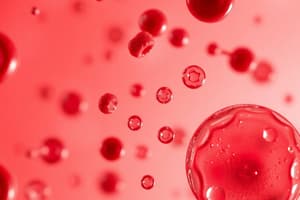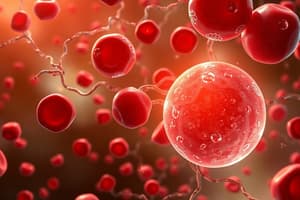Podcast
Questions and Answers
If a patient's blood is found to have a significantly lower than normal erythrocyte count, what physiological consequence is most likely to occur?
If a patient's blood is found to have a significantly lower than normal erythrocyte count, what physiological consequence is most likely to occur?
- Increased blood clotting efficiency leading to thrombosis
- Reduced oxygen-carrying capacity resulting in tissue hypoxia (correct)
- Increased blood viscosity leading to hypertension
- Elevated blood osmolarity causing cellular dehydration
A patient presents with a blood test indicating elevated levels of lymphocytes. Which potential condition should be investigated, considering lymphocyte function?
A patient presents with a blood test indicating elevated levels of lymphocytes. Which potential condition should be investigated, considering lymphocyte function?
- Active bacterial infection due to increased phagocytosis.
- Increased blood clotting due to enhanced platelet aggregation.
- Autoimmune disorder or viral infection as lymphocytes target specific antigens. (correct)
- Impaired oxygen transport due to lymphocyte interference with hemoglobin.
A researcher is investigating the role of specific blood components in maintaining blood viscosity and osmolarity. Which component would be most relevant to study?
A researcher is investigating the role of specific blood components in maintaining blood viscosity and osmolarity. Which component would be most relevant to study?
- Albumin, as it significantly contributes to osmotic pressure and viscosity. (correct)
- Platelets, due to their role in blood clotting.
- Erythrocytes, due to their role in oxygen transport.
- Leukocytes, due to their immune functions.
A patient with a history of liver disease exhibits prolonged bleeding after a minor injury. What is the most likely underlying cause related to liver function?
A patient with a history of liver disease exhibits prolonged bleeding after a minor injury. What is the most likely underlying cause related to liver function?
What is the primary reason erythrocytes rely on anaerobic fermentation for energy, instead of aerobic respiration?
What is the primary reason erythrocytes rely on anaerobic fermentation for energy, instead of aerobic respiration?
Following a blood donation, an individual might experience a temporary decrease in blood volume. What compensatory mechanism does the body primarily employ to restore blood pressure and volume?
Following a blood donation, an individual might experience a temporary decrease in blood volume. What compensatory mechanism does the body primarily employ to restore blood pressure and volume?
In a patient with chronic kidney disease, erythropoietin production is often impaired. What is the most likely consequence of this impairment?
In a patient with chronic kidney disease, erythropoietin production is often impaired. What is the most likely consequence of this impairment?
A researcher is studying the effects of different blood components on inflammation. Which of the following cellular components is MOST directly involved in limiting the spread of infection by initiating inflammatory responses?
A researcher is studying the effects of different blood components on inflammation. Which of the following cellular components is MOST directly involved in limiting the spread of infection by initiating inflammatory responses?
Why is knowledge about blood groups crucial in medicine?
Why is knowledge about blood groups crucial in medicine?
A patient with a genetic defect lacks the ability to produce fibrinogen. What direct consequence would this deficiency have on their hemostatic capabilities?
A patient with a genetic defect lacks the ability to produce fibrinogen. What direct consequence would this deficiency have on their hemostatic capabilities?
What describes the role of Vitamin K in clot formation?
What describes the role of Vitamin K in clot formation?
During pregnancy, there's an increased risk of blood clot formation (thrombosis). Which of the listed changes in blood composition during pregnancy most directly contributes to this increased risk?
During pregnancy, there's an increased risk of blood clot formation (thrombosis). Which of the listed changes in blood composition during pregnancy most directly contributes to this increased risk?
What would occur if the intrinsic pathway to coagulation was blocked?
What would occur if the intrinsic pathway to coagulation was blocked?
During childbirth, mothers and infants get extra Vitamin K supplements, why is this?
During childbirth, mothers and infants get extra Vitamin K supplements, why is this?
During a normal blood test, normal erythrocytes are observed. However, the patient has a hemoglobin of 33%. What would be the consequences of reducing the hemoglobin count?
During a normal blood test, normal erythrocytes are observed. However, the patient has a hemoglobin of 33%. What would be the consequences of reducing the hemoglobin count?
Why might a kidney failure patient get shots of erythropoietin?
Why might a kidney failure patient get shots of erythropoietin?
A patient has a low white blood cell count, otherwise known as leukopenia. What is a possible outcome of this?
A patient has a low white blood cell count, otherwise known as leukopenia. What is a possible outcome of this?
What is the primary reason a blood bank centrifuges blood?
What is the primary reason a blood bank centrifuges blood?
What property of veins prevents abnormal coagulation?
What property of veins prevents abnormal coagulation?
Which sequence of events will happen after clotting?
Which sequence of events will happen after clotting?
In a condition of hypoxemia, what direct action will the body undertake?
In a condition of hypoxemia, what direct action will the body undertake?
If a patient's digestive tract has trouble absorbing nutrients, this can result in a blood disorder. What is the connection here?
If a patient's digestive tract has trouble absorbing nutrients, this can result in a blood disorder. What is the connection here?
What might cause blood to flow slower than normal?
What might cause blood to flow slower than normal?
What is the ultimate goal of coagulation?
What is the ultimate goal of coagulation?
Which of the following lists a series of functions performed by the circulatory system?
Which of the following lists a series of functions performed by the circulatory system?
Flashcards
Circulatory System: Transport
Circulatory System: Transport
The circulatory system transports O2, CO2, nutrients, wastes, hormones, and stem cells.
Circulatory System: Protection
Circulatory System: Protection
The circulatory system protects by limiting infection spread, destroying cancer/foreign cells, and initiating clotting.
Circulatory System: Regulation
Circulatory System: Regulation
The circulatory system regulates fluid distribution, blood pressure, and pH.
Blood Plasma
Blood Plasma
Signup and view all the flashcards
Blood Plasma Proteins
Blood Plasma Proteins
Signup and view all the flashcards
Albumin
Albumin
Signup and view all the flashcards
Globulins
Globulins
Signup and view all the flashcards
Fibrinogen
Fibrinogen
Signup and view all the flashcards
Nitrogenous Wastes
Nitrogenous Wastes
Signup and view all the flashcards
Osmolarity
Osmolarity
Signup and view all the flashcards
Blood Viscosity
Blood Viscosity
Signup and view all the flashcards
hemopoiesis
hemopoiesis
Signup and view all the flashcards
Hematocrit
Hematocrit
Signup and view all the flashcards
Hypoxemia
Hypoxemia
Signup and view all the flashcards
Erythropoietin (EPO)
Erythropoietin (EPO)
Signup and view all the flashcards
Anemia
Anemia
Signup and view all the flashcards
Neutrophils
Neutrophils
Signup and view all the flashcards
Eosinophils
Eosinophils
Signup and view all the flashcards
Basophils
Basophils
Signup and view all the flashcards
Lymphocytes
Lymphocytes
Signup and view all the flashcards
Monocytes
Monocytes
Signup and view all the flashcards
Clotting process in blood vessels.
Clotting process in blood vessels.
Signup and view all the flashcards
Coagulation goal
Coagulation goal
Signup and view all the flashcards
Coagulation process
Coagulation process
Signup and view all the flashcards
Study Notes
Circulatory System Functions
- Transports oxygen and carbon dioxide
- Transports nutrients from the digestive tract
- Transports waste from metabolism
- Transports hormones
- Transports stem cells to other tissues
- Provides protection via inflammation (limits infection spread)
- Destroys cancer cells, foreign cells, and toxins
- Initiates clotting
- Regulates fluid distribution and blood pressure
- Regulates pH
Blood Components
- Total blood volume is 4-6 Liters
- Consists of plasma and formed elements
- Erythrocytes (RBCs) are a formed element
- Leukocytes (WBCs) are a formed element
- This includes Neutrophils, Eosinophils, and Basophils
- Monocytes and Lymphocytes are also leukocytes
- Platelets are a formed element
Blood Plasma Constituents
- Clear, light-yellow fluid
- Water comprises 92% of plasma mass
- Contains proteins
- Contains nutrients
- Contains electrolytes
- Contains waste
- Contains hormones
- Contains gases
Blood Plasma Proteins
- Proteins are the most abundant solute
- Functions include clotting, pathogen defense, and solute transport
- Proteins are produced by the liver, except for some globulins
- Albumin accounts for 60% of plasma proteins
- Transports solutes
- Buffers pH
- Contributes to viscosity and osmolarity
- Globulins account for 36% of plasma proteins
- Involved in solute transport and clotting
- Contribute to immunity
- Fibrinogen accounts for 4% of plasma proteins
- It's the precursor to fibrin
- Fibrin forms the framework of blood clots
Other Blood Plasma Components
- Nitrogenous wastes are toxic end products of catabolism
- Urea is a waste product of amino acid breakdown
- Excreted through the kidneys into urine
- Nutrients found in blood plasma
- Glucose
- Amino acids
- Fats
- Cholesterol
- Vitamins
- Minerals
- Electrolytes comprise 90% of blood plasma
Blood Viscosity and Osmolarity
- Blood is approximately 5x more viscous than water
- Viscosity disorders can occur due to
- RBC or protein deficiency, leading to higher blood flow
- Too many RBCs or protein, leading to slower blood flow
- Strain on the heart and heart disease
- Osmolarity measures solute concentration in blood
- High osmolarity leads to increased water absorption, causing high blood pressure
- Sodium and proteins influence osmolarity
Blood Production
- Blood loss is a trigger for blood production
- This includes bleeding
- RBCs aging and dying
- Plasma components being used or excreted
- Hemopoietic tissues are responsible for blood formation
- Liver carries out hemopoiesis until birth
- Also Spleen, Thymus and bone marrow produce blood cells
Erythrocytes (RBCs)
- Facilitate gas exchange
- Mature RBCs lack a nucleus and organelles
- Rely on anaerobic fermentation for energy
- Do not respire aerobically, to conserve oxygen for delivery to tissues
- Cytoplasm contains
- Hemoglobin constitutes 33% of the cytoplasm
- Carbonic anhydrase
RBCs and Hemoglobin Measurement
- Measurement of these constituents provides clinical insight into oxygen carrying capacity
- Hematocrit measures the % of blood volume that is RBCs
- Hemoglobin concentration is also measured
- RBC count is determined
- Normal values are higher in men (42-52%) than in women (37-48%)
- Androgens stimulate RBC production
- Periodic menstrual RBC loss affects RBC levels in women
- Inversely proportional to body fat
- Broken down in the spleen
RBC Homeostasis
- Regulated via negative feedback
- Low RBC count triggers hypoxemia
- Kidneys detect hypoxemia and increase EPO output
- EPO is erythropoietin
- Normal RBC levels are reached within a few days
- Other causes of hypoxemia may be
- Low atmospheric oxygen
- Lethargy active through exercise
- Emphysema may cause chronic hypoxemia that can't be corrected
Leukocytes - Granulocytes
- Neutrophils (60-70%)
- Lysozyme & antimicrobial agents
- Antibacterial
- Phagocytosis & antimicrobial chemicals
- Eosinophils (2-4%)
- Mucus membranes
- Granules; fight large parasites and Hookworms/ tapeworms
- Allergies
- Basophils (
Studying That Suits You
Use AI to generate personalized quizzes and flashcards to suit your learning preferences.




